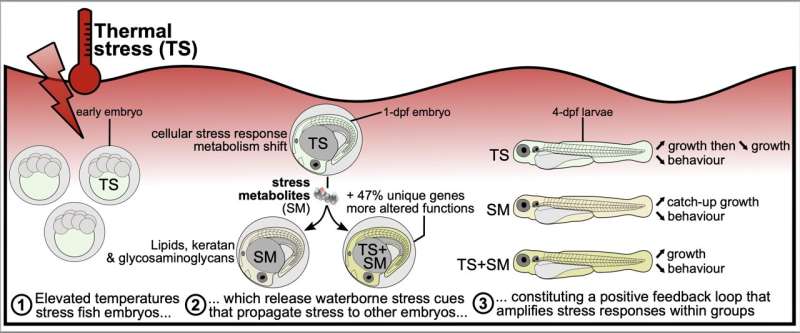Conceptual summary of stress-induced communication mediated through stress metabolites in zebrafish embryos. Credit: Feugere et al
Heat-stressed fish embryos release chemical signals that change the appearance, behavior, and development of fish embryos that were not heat stressed, according to a study. Stress during development can change how an embryo grows and which genes are activated. Katharina Wollenberg Valero and colleagues explored how stress might be communicated to other animals and what the consequences are. Their work is published in the journal PNAS Nexus.
Using zebrafish (Danio rerio), a classic model organism, the authors heated embryos to a stressful +5℃ over normal temperature, a temperature that is expected to occur more frequently during heat waves. The authors found that heat-stressed embryos tended to grow more quickly, show reduced response to new stimuli, and hatch early compared to controls.
The authors then looked within the embryos' growth medium for chemical cues that could act as messengers of heat stress and found that "stress metabolites" include both sulfur-containing compounds and fats. Next, the authors exposed other zebrafish embryos to these stress metabolites to see whether the embryos react in similar ways to the cues as to heat stress itself.
The authors found that the stress metabolites influenced activity of genes associated with immune response, extracellular signaling, as well as with structural components of the cell membrane such as sugars and fats. These non-heat-stressed embryos showed a pattern of quick growth and reduced activity that was similar to that of the heat-stressed embryos, but achieved through a different molecular pathway. According to the authors, such propagation of heat stress across groups of individuals has implications for both ecology and animal welfare in a warming world.
More information: Lauric Feugere et al, Heat induces multiomic and phenotypic stress propagation in zebrafish embryos, PNAS Nexus (2023). DOI: 10.1093/pnasnexus/pgad137
Journal information: PNAS Nexus
Provided by PNAS Nexus
























